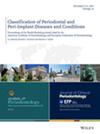Gingival crevicular fluid during experimental gingivitis: A review of immune and tissue regulation
IF 3.8
2区 医学
Q1 DENTISTRY, ORAL SURGERY & MEDICINE
引用次数: 0
Abstract
BackgroundThis systematic review summarized the features of human experimental gingivitis (EG) in terms of immune responses and tissue remodeling in the gingival crevicular fluid (GCF).MethodsSystematic searches were conducted to screen the literature published from January 1960 to June 2024 from MEDLINE (PubMed), EMBASE, and Web of Science. The selected studies were prospective trials evaluating the immune responses and tissue remodeling mediators in GCF before and after EG via oral hygiene refrain. Evidence quality and risk of bias were assessed.ResultsThirty studies with 594 volunteers met the inclusion criteria, analyzing 74 clinical parameters and biomarkers in GCF samples. Consistent with EG induction, the EG sites showed an increase in plaque index (PI), gingival index (GI), and myeloperoxidase (MPO) (an indicator of neutrophil migration). In addition, the expression levels of interleukin (IL)‐1α and IL‐1β were increased, also consistent with the previous literature investigating active lesions of periodontal inflammation during gingivitis. However, the expression of macrophage inflammatory protein (MIP)‐1 β, monocyte chemoattractant protein (MCP)‐1, CCL2, and fractalkine/CX3CL1 decreased among EG in multiple studies demonstrating an EG effect on recruitment and cellular communication of mononuclear cells. In contrast, the levels of fibroblast growth factors (FGFs), vascular endothelial growth factor (VEGF), and anti‐inflammatory cytokines showed insignificant changes during EG induction. Aging, stress level, and the diabetes status of the volunteer populations affected the outcomes.ConclusionsThe features of acute inflammatory lesions of EG with limited tissue destruction showcase that it is a valuable tool to investigate the initial immune responses on gingival tissue against bacterial challenges.Plain Language SummaryThis review examined how human experimental gingivitis (EG) affects immune responses and tissue changes in the fluid around the gums. Researchers analyzed studies published from 1960 to 2024, focusing on those that looked at immune responses and tissue changes in gum fluid before and after participants stopped brushing their teeth to induce EG. The review included 30 studies with 594 participants, exploring various health markers in gum fluid. When EG was induced, areas of the gums showed increased plaque and markers of inflammation, indicating an inflammatory response. Specifically, two inflammatory proteins (interleukin [IL]‐1α and IL‐1β) were found in greater expression, which aligns with what previous research has shown in gum disease. However, levels of certain proteins that help attract monocytes and macrophages decreased, suggesting changes in how these cells communicate during EG. Additionally, the levels of growth factors and anti‐inflammatory substances did not change significantly. Factors such as age, stress, and diabetes also influenced the outcomes. These findings help us understand early immune responses in gum disease, which is crucial for developing prevention strategies and improving oral health overall.实验性牙龈炎期间牙龈沟液:免疫和组织调节的综述
本系统综述了实验性牙龈炎(EG)在龈沟液(GCF)免疫应答和组织重塑方面的特点。方法系统检索MEDLINE (PubMed)、EMBASE和Web of Science网站1960年1月至2024年6月发表的文献。所选择的研究是前瞻性试验,通过口腔卫生试验评估EG前后GCF中的免疫反应和组织重塑介质。评估证据质量和偏倚风险。结果30项研究594名志愿者符合纳入标准,分析了GCF样本中的74项临床参数和生物标志物。与EG诱导一致,EG位点显示斑块指数(PI),牙龈指数(GI)和髓过氧化物酶(MPO)(中性粒细胞迁移指标)增加。此外,白细胞介素(IL)‐1α和IL‐1β的表达水平升高,这也与先前研究牙龈炎期间牙周炎症活动性病变的文献一致。然而,在多项研究中,巨噬细胞炎症蛋白(MIP)‐1 β、单核细胞趋化蛋白(MCP)‐1、CCL2和fractalkine/CX3CL1的表达在EG中下降,表明EG对单核细胞的募集和细胞通讯有影响。相比之下,成纤维细胞生长因子(FGFs)、血管内皮生长因子(VEGF)和抗炎细胞因子的水平在EG诱导过程中没有明显变化。志愿者人群的年龄、压力水平和糖尿病状况影响结果。结论龈下急性炎性病变伴有限组织破坏的特点为研究龈下组织对细菌攻击的初始免疫反应提供了一种有价值的工具。本文综述了人类实验性牙龈炎(EG)如何影响免疫反应和牙龈周围液体的组织变化。研究人员分析了1960年至2024年发表的研究,重点关注了参与者停止刷牙诱导EG前后的免疫反应和牙龈液组织变化。该综述包括30项研究,涉及594名参与者,探索牙龈液中的各种健康指标。当EG被诱导时,牙龈区域显示出增加的菌斑和炎症标志物,表明炎症反应。具体来说,两种炎症蛋白(白细胞介素[IL]‐1α和IL‐1β)的表达更高,这与之前的研究结果在牙龈疾病中一致。然而,某些有助于吸引单核细胞和巨噬细胞的蛋白质水平下降,表明这些细胞在EG期间的通讯方式发生了变化。此外,生长因子和抗炎物质的水平没有显著变化。年龄、压力和糖尿病等因素也会影响结果。这些发现有助于我们了解牙龈疾病的早期免疫反应,这对于制定预防策略和改善整体口腔健康至关重要。
本文章由计算机程序翻译,如有差异,请以英文原文为准。
求助全文
约1分钟内获得全文
求助全文
来源期刊

Journal of periodontology
医学-牙科与口腔外科
CiteScore
9.10
自引率
7.00%
发文量
290
审稿时长
3-8 weeks
期刊介绍:
The Journal of Periodontology publishes articles relevant to the science and practice of periodontics and related areas.
 求助内容:
求助内容: 应助结果提醒方式:
应助结果提醒方式:


